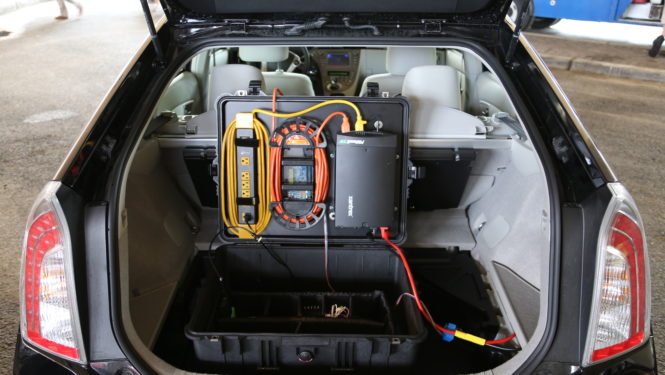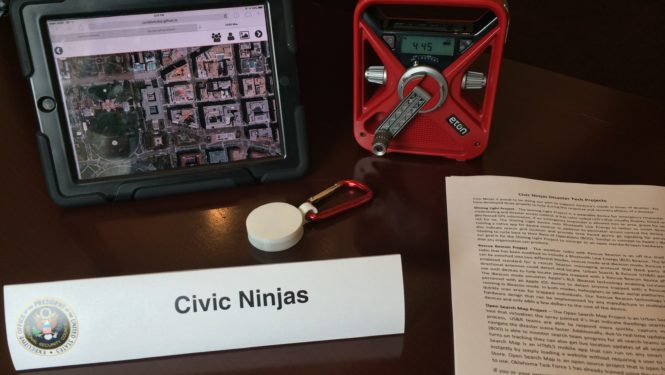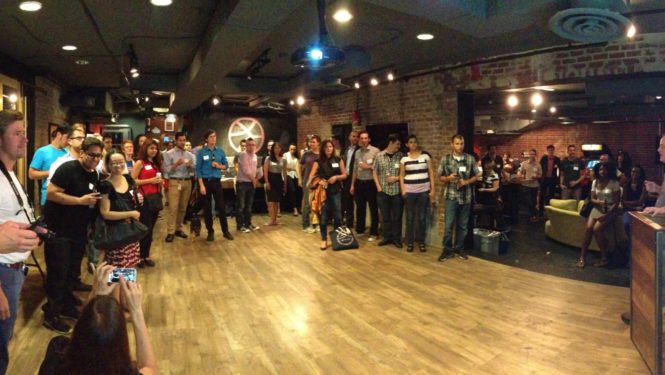Part of a series about 2017 National Week of Making.
Civic Ninjas are putting the power back into people’s hands when disasters strike.
The Tulsa-based group of makers, developers, designers, technologists, thinkers and tinkerers has created a Citizen Power Brigade. This initiative turns ordinary people into first responders and their hybrid electric cars into mobile emergency power sources, which can help reconnect people in the aftermath of a disaster.
Civic Ninjas has developed a Field Power Kit, which fits into a duffel bag and enables one hybrid car to charge 8400 cell phones and similar devices for one week. That’s equivalent to 12 million minutes of talk time for disaster survivors as they try to reach friends, family and the services that are trying to help them.

“The reality that nobody is talking about in the disaster space is that 24 hours into a massive disaster, all of our mobile devices will be dead and there will be no power to charge any of them,” says Scott Phillips, the founder of Civic Ninjas.
“So we solved the problem by using hybrid electric vehicles as the world’s cleanest burning, most fuel efficient source of mobile emergency power in disasters, and we turned hybrid vehicle owners into a new type of first responder.”
Civic Ninjas have also developed other open-source solutions for better disaster response and recovery, such as FirePi Dispatch and Open Search Map.
Much of this work was inspired by the aftermath of Hurricane Sandy, which struck in 2012 and was the second-costliest hurricane in US history. According to Scott, the response was botched by many, and the White House spent the next two years pushing for better response and resilience to disasters. Civic Ninjas heeded the call.
The Democracy of Making
But the ninjas don’t just do disasters or power up phones. They focus on building community and empowering people through their activities, events, training and services.

Since 2010, Civic Ninjas has grown from a small group of 40 to 50 people having informal get-togethers over beers to a constellation of projects, tech groups, hackathons, community events, workshops and support services that all feed into each other. Part community, part organization, part business, the ninjas see themselves mostly as a “group of like-minded folks working to make a difference”.
“Civic Ninjas is a bit of a unique organisation because we focus on — in no particular order — the maker movement, civic technology and entrepreneurship. The connective thread to those three things is the fact that these movements are democratising access to how we live, work and play,” says Scott.
Building Communities and Smart Cities
According to Scott, these movements transition people from consumers to makers and empowers them to make a difference in their communities. This transition is also about emerging “smart cities”. “The maker movement is going to give people tools to better engage with their cities,” he says.
It’s also going to help build stronger and more resilient communities.
“One of the Civic Ninjas’ taglines is: community makes the world possible. Things like the maker movement, things like civic technology, they become rallying points that allow us to build community,” Scott says.
“And then part of the secret sauce has been identifying community needs that further inspire the community to solve those problems. Solving those problems empowers people and allows them to spread their wings beyond their involvement with Civic Ninjas.”
Parallel Worlds
Scott sees this conversation about civic engagement, communities and cities as particularly pertinent to Burning Man given “some of the frustrations and opportunities you guys are seeing around better citizenship”.
“When I think about the original motivation for Burning Man, it’s an experimental platform to learn what’s possible and then return what’s possible to broader communities,” he says.
But that last leg of the loop has become progressively lost as more and more people just pile in to party.
“Getting people to realise that they have ownership is the ultimate outcome [of the maker movement and civic technology movements]. And if you look at Self-reliance, that’s really about ownership, too. So if we can take those concepts and diffuse them into mainstream communities and government, I think that’s a huge win,” says Scott.

